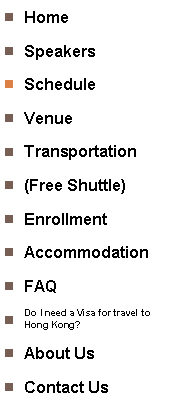
|
Schedule |

|
© Copyright Advanced Statistic Modeling. All rights reserved |
|
08:00-08:30 Registration 08:30-10:00 Welcome Speech & Lecture 1: Factor Analysis 10:00-10:15 Coffee/Tea Break 10:15-12:00 Lecture 2: Structural Equation Modeling 12:00-13:30 Lunch (Participants are on their own for lunch) 13:30-15:00 Lecture 3: Growth Modeling 15:00-15:15 Complimentary Coffee/Cold drinks Break 15:15-16:45 Lecture 4: Advanced Growth Modeling |
|
08:00-08:30 Registration 08:30-10:00 Lecture 1: Latent class analysis 10:00-10:15 Coffee/Tea Break 10:15-12:00 Lecture 2: Latent Transition Analysis 12:00-13:30 Lunch (Participants are on their own for lunch) 13:30-15:00 Lecture 3: Growth Mixture Modeling 15:00-15:15 Complimentary Coffee/Cold drinks Break 15:15-16:45 Lecture 4: Multilevel regression and path analysis |
|
08:00-08:30 Registration 08:30-10:00 Lecture 1: 2- and 3- Level Factor Analysis and SEM 10:00-10:15 Coffee/Tea Break 10:15-12:00 Lecture 2: The unique IRT strength of Mplus V7: Multilevel, mixture, & random intercept/random loading parameters, multiple-group analysis 12:00-13:30 Lunch (Participants are on their own for lunch) 13:30-15:00 Lecture 3: Crossed-random effects, random items and contexts 15:00-15:15 Complimentary Coffee/Cold drinks Break 15:15-16:45 Lecture 4: Further Bayes analysis news in Mplus Version 7. Causally-defined mediation effects. LCA/LTA simplifications |
|
The generality of latent variable modeling using Mplus The use of latent variables is a common theme in many statistical analyses. Continuous latent variables appear not only as factors measured with errors in factor analysis, item response theory, and structural equation modeling, but also appear in the form of random effects in growth modeling, components of variation in complex survey data analysis and multilevel modeling, frailties and liabilities in survival and genetic analyses, latent response variables with missing data, priors in Bayesian analysis, and as counterfactuals and potential outcomes in causal analysis. In addition, categorical latent variables appear as latent classes in finite mixture analysis and latent transition analysis (Hidden Markov modeling), latent trajectory classes in growth mixture modeling, and latent response variables with missing data on categorical variables. Understanding the unifying theme of latent variable modeling provides a way to break down barriers between seemingly disparate types of analyses. Researchers need to be able to move freely between analysis types to more easily answer their research questions. To provide answers to the often complex substantive questions, it is also fruitful to use latent variable techniques to combine different analysis types. This short course gives several recent examples of the potential of such ideas, including the combination of exploratory factor analysis (EFA) and structural equation modeling (SEM) to perform multiple-group EFA of classroom behavior, combining SEM with Bayesian analysis to perform a more flexible type of Bayesian confirmatory factor analysis, combining latent class and survival analysis to study patient-reported outcomes and cancer survival, combining growth mixture modeling with survival analysis to study non-ignorable dropout in antidepressant clinical trials, and combining latent class and causal analysis to study randomized trial effects in the presence of non-compliance with treatment. All these analyses can be carried out using the general latent variable modeling framework of the Mplus program. The detailed schedule is as following. Please note that The teaching is in lecture form giving an overview of Mplus modeling, including discussions of Mplus input and output, as well as question and answer sessions. No computer exercises will take place and there is no need to bring computers. |



